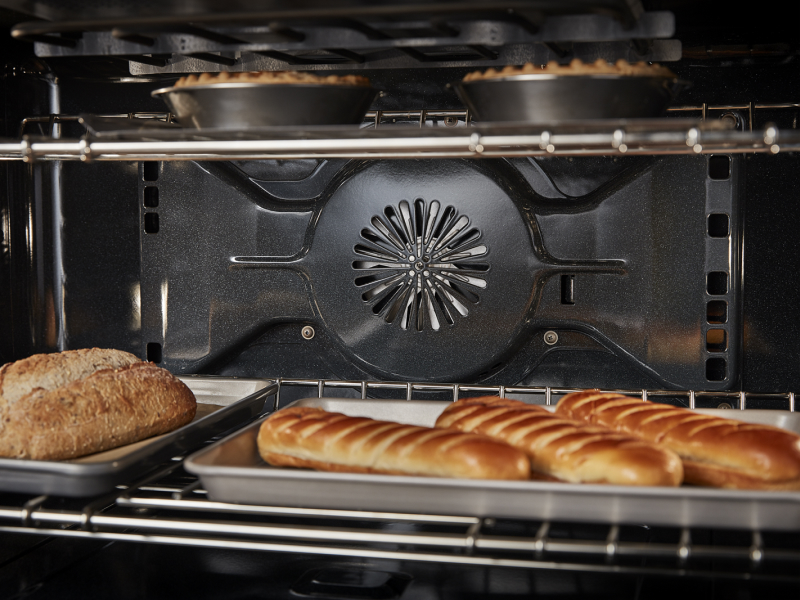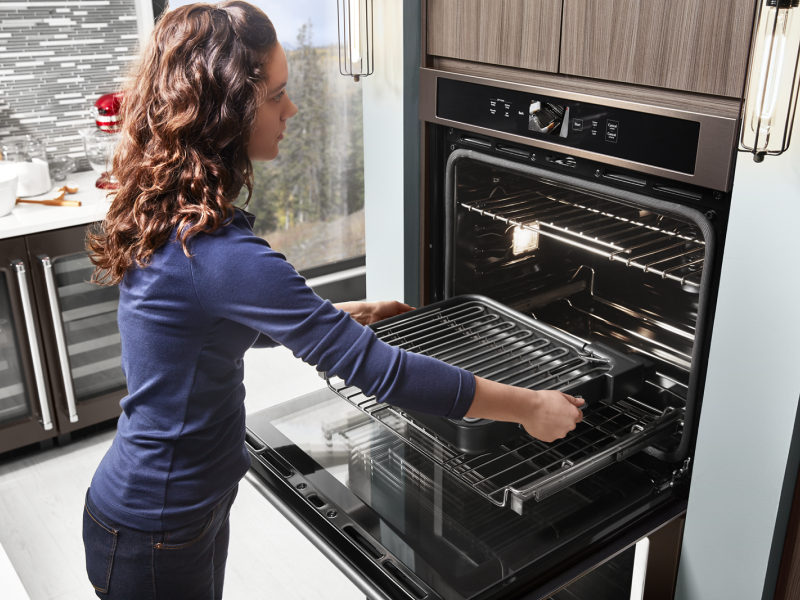
In the realm of culinary creations, ovens stand as indispensable tools, capable of transforming raw ingredients into delectable masterpieces. From the humble roast chicken to the delicate pastry, ovens orchestrate a symphony of heat and time, coaxing out the essence of flavors and textures. To truly appreciate the culinary magic that unfolds within these culinary maestros, let’s delve into the intricacies of how ovens work, exploring the principles of heat transfer, the nuances of different oven types, and the factors that influence their performance.
A Symphony of Heat Transfer: Conduction, Convection, and Radiation
At the heart of an oven‘s ability to transform food lies the intricate interplay of heat transfer mechanisms. Conduction, the direct transfer of heat from one object to another, plays a crucial role in ovens. As heating elements radiate warmth, it gradually spreads to nearby surfaces, such as baking trays and food items.
Convection, the movement of heated air currents, takes center stage in many modern ovens. Fans strategically placed within the oven cavity propel hot air, ensuring even heat distribution throughout the cooking chamber. This efficient heat transfer mechanism results in consistent cooking and prevents the dreaded hot spots that can lead to uneven browning.
Radiation, the transfer of heat through electromagnetic waves, adds another dimension to the oven’s arsenal. Infrared radiation, emitted by heating elements, penetrates food, causing molecules to vibrate and generate heat from within. This direct heat transfer contributes to browning and crisping, adding a delightful touch of texture to culinary creations.
Conventional Electric Ovens: A Classic Choice
Conventional electric ovens, with their familiar heating elements and thermostats, have long been a staple in kitchens worldwide. These reliable workhorses utilize both conduction and radiation to cook food, with heating elements typically positioned at the top and bottom of the oven cavity.
Thermostats, the watchful guardians of temperature, ensure consistent heat levels within the oven. By sensing the internal temperature and communicating with the heating elements, thermostats maintain the desired cooking environment, preventing overheating or undercooking.
Insulation, the invisible barrier against heat loss, plays a critical role in the efficiency of electric ovens. Fiberglass, mineral wool, and other insulating materials form a protective shield around the oven cavity, trapping heat within and minimizing energy consumption.
Gas Ovens: Harnessing the Power of Flame
Gas ovens, fueled by natural gas or propane, offer a unique blend of power and precision. Flame burners, typically located at the bottom of the oven cavity, provide intense heat, allowing for rapid preheating and versatile cooking techniques.
The combustion process, the controlled burning of fuel to generate heat, lies at the heart of gas ovens. Air intake and exhaust vents ensure proper combustion, while safety features like flame failure sensors and gas shutoff valves safeguard against potential hazards.
Gas ovens, like their electric counterparts, employ thermostats to regulate temperature. These vigilant regulators monitor the oven’s internal temperature and adjust the gas flow accordingly, ensuring consistent heat levels throughout the cooking process.
Expanding Culinary Horizons: Convection, Microwave, and Steam Ovens
Beyond the realm of conventional electric and gas ovens lies a world of culinary possibilities, where convection, microwave, and steam ovens offer unique advantages and expand the horizons of home cooking.
Convection ovens, equipped with fans that circulate hot air throughout the cavity, excel at even cooking and reduced baking times. The forced convection ensures consistent heat distribution, eliminating hot spots and producing perfectly browned and crispy dishes.
Microwave ovens, harnessing the power of microwave radiation, offer rapid heating and defrosting capabilities. Microwave radiation directly penetrates food, causing water molecules to vibrate and generate heat, resulting in quick and convenient cooking.
Steam ovens, masters of gentle cooking, utilize steam to preserve nutrients and enhance flavors. Steam, generated within the oven cavity, surrounds food, cooking it from the inside out without drying it out. This delicate cooking method is ideal for vegetables, fish, and other delicate ingredients.
Factors Influencing Oven Performance: Size, Insulation, and More
When selecting and using an oven, several factors contribute to its overall performance and ability to produce culinary masterpieces.
Oven size and capacity play a crucial role in cooking efficiency and energy consumption. A properly sized oven should accommodate the needs of the household, without consuming excessive energy when cooking smaller meals.
Oven insulation, the invisible guardian against heat loss, significantly impacts preheating times, temperature consistency, and energy efficiency. Well-insulated ovens preheat quickly, maintain consistent temperatures, and minimize energy consumption.
Oven placement, often overlooked, can influence its performance. Avoid placing ovens near heat sources or vents, as external heat can interfere with temperature regulation.
A Culinary Journey Powered by Heat
Ovens, with their intricate interplay of heat transfer mechanisms and diverse types, stand as indispensable tools in the culinary arsenal. From the classic electric and gas ovens to the innovative convection, microwave, and steam models, each type offers unique advantages and expands the culinary possibilities. Understanding the science behind these culinary marvels empowers us to choose the right oven for our needs, utilize its functions effectively, and embark on a delicious journey of culinary exploration. So, the next time you preheat your oven and witness the transformation of raw ingredients into delectable dishes, remember the intricate dance of heat transfer and the ingenuity of engineering that lies at the heart of this essential kitchen appliance. With this newfound knowledge, you can unlock a world of culinary possibilities and become a true master of your own kitchen domain.
Essential Tips for Mastering Your Oven
Having explored the science behind ovens and the diverse types available, let’s delve into some practical tips to maximize their performance and elevate your culinary creations:
-
Preheat Properly: Always preheat your oven to the recommended temperature before placing food inside. This ensures even cooking and prevents uneven browning or undercooked centers.
-
Placement Matters: Strategically position your food within the oven. For even heat distribution, utilize the center rack for most baking and roasting tasks. Adjust the rack height depending on the recipe; for better browning, use a higher rack position.
-
Don’t Crowd the Oven: Overcrowding the oven can hinder air circulation and lead to uneven cooking. Leave adequate space between baking dishes to allow hot air to flow freely.
-
Know Your Oven: Every oven has its own quirks and temperature variations. Invest in an oven thermometer to verify the accuracy of your oven’s internal temperature gauge.
-
Utilize Baking Sheets: Baking sheets promote even heat distribution and prevent soggy bottoms for cookies, pastries, and other baked goods. Parchment paper placed on baking sheets facilitates easy cleanup.
-
Rotate Your Food: For even browning and cooking, especially while roasting meats or vegetables, rotate your baking sheets or dishes halfway through the cooking time.
-
Resting is Key: After removing food from the oven, allow it to rest for a few minutes before serving. This allows the internal juices to redistribute, resulting in a more flavorful and tender dish.
-
Cleaning is Crucial: Regularly clean your oven to remove food residue and grease buildup. This ensures optimal performance, prevents unwanted odors, and extends the lifespan of your appliance.
By following these simple yet effective tips, you can transform your oven from a basic appliance into a tool for culinary mastery.
A Look Towards the Future: Innovation in Oven Technology
The world of ovens is constantly evolving, with advancements in technology paving the way for exciting new features and improved functionality:
-
Smart Ovens: These internet-connected ovens offer a glimpse into the future of cooking. With integrated Wi-Fi and smartphone apps, they allow for remote monitoring, temperature adjustments, and even recipe-specific cooking cycles.
-
Self-Cleaning Ovens: The bane of many home cooks, oven cleaning may soon become a relic of the past. Self-cleaning ovens utilize a high-heat cycle to burn off grease and food residue, leaving minimal ash for easy removal.
-
Steam-Assisted Ovens: Combining the versatility of conventional ovens with the benefits of steam cooking, steam-assisted ovens offer the best of both worlds. They allow for even browning and crispy textures while preserving nutrients and moisture in food.
-
Rapid Cooking Technologies: Innovations like induction heating and rapid air circulation are revolutionizing cooking times. These advancements promise faster preheating times and significantly reduced cooking durations.
As technology continues to evolve, we can expect even more innovative features and functionalities to be incorporated into ovens. These advancements will further simplify the cooking process, enhance food quality, and open up new possibilities for culinary exploration.
In conclusion, ovens are more than just simple appliances; they are culinary companions that unlock a world of delicious possibilities. By understanding the science behind them, utilizing them effectively, and keeping an eye on the future of oven technology, you can transform your kitchen into a haven of culinary creativity. So, preheat your oven, embrace the science of heat transfer, and embark on a delicious journey of culinary exploration.